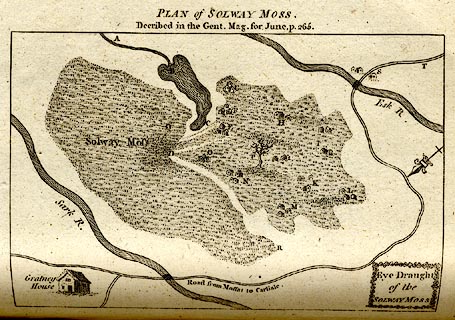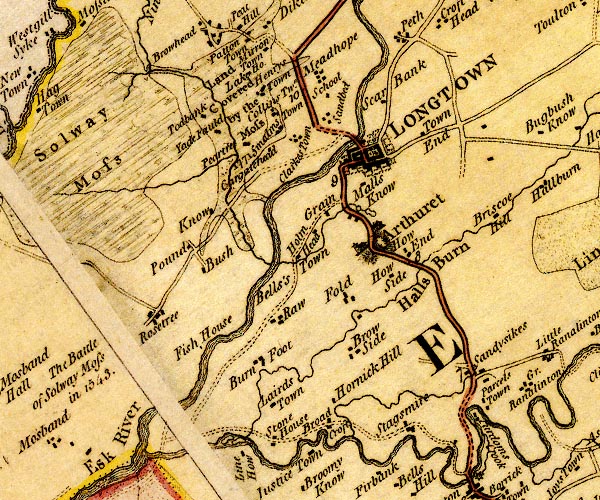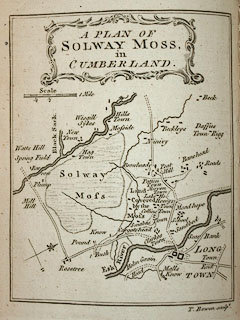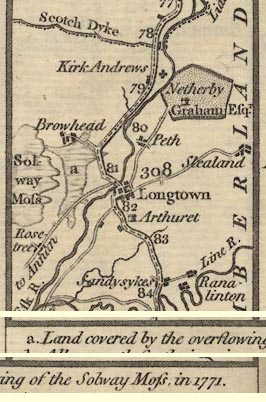




item:- flood, 1771
 goto source
goto sourceGentleman's Magazine 1771 pp.567-568 "Thursday, 12."
"A letter from Edinburgh, of this day's date, gives the following particulars of the ravages sustained by the moveable moss:"
""Solway moss still continues to move, and it began to flow on Saturady last with more rapidity than it has done for three weeks past."
"The following is a list of the names and number of the farms destroyed by the eruption of Solway flow in Cumberland, together with the number of farmers who possessed these farms, and the rental ofthese lands, as present paid to Mr. Graham of Netherby, proprietor of Solway flow, and the lands now covered by it. Taken at Solway flow, on Tuesday, Dec. 3, 1771."
"The above farms are so greatly destroyed, that twenty three families of the farmers, besides cotters, are obliged to leave their ruined houses; some of them being knocked down by the force of the eruption, others of them covered almost to the top of the side walls by the moss."
"The following four farms are only partly covered, the houses being inhabited, viz."
"This is the present rental of all the land that is covered by the eruption of the moss; and, if these lands are set, on an average, at twelve shillings per acre, the quantity of ground covered must be four hundred acres and fifty-three poles."
"The land upon which the moss has flowed, is covered by it from twelve to thirty feet deep. The eruption began on Saturday the 15th of November last, about eleven o'clock at night. It broke out from the Solway flow, on the north-east side, by a gullet of about a hundred yards wideness. At a very short distance from the mouth of the gullet, it spread at the wideness of almost a mile square, over above four hundred acres of the best land in the north of England. It still continues to flow out of the gullet in a very rapid current, carrying along with it a large quantity of moss, which it forces from below the surface, and, even in some places, the solid surface along with it, which, by floating upon the moss that hath covered the lands in the beds of Esk, gives them altogether the appearance of having been a moss from time immemorial. As it flows at present, so it must, from the very nature of the thing, continue to flow for ages. That it may do least damage, its course should either be diverted to the river of Sark, on the west side of Solway flow, or else a clear passage made in its present direction to the river of Esk; both of which are practicable, but at considerable expence. However, if some such method is not taken, much more exceeding good land will be covered by it."
"The cause of the eruption is so evident, from the situation of Solway flow, and of the adjacent lands on the east side of it, with the former management of those who have casten their peats on the Solway flow, that it is more wonderful to the person who hath taken the above account, that the Solway flow hath stood so long, than that it hath now broke out, and overflowed so great a quantity of ground upon the beds of Esk. It will be next to impossible, ever again to clear the covered land by burning the moss; though it appears probable to me, that there is a possibility of clearing it by water. The greatest part of the surface of the old moss is still whole; but it is now so much out, that, though formerly level, the middle of it is like a large glen between two hills, declining from each other.""
| Names of the farms. | Farmers. | Rental. |
| L.s.d. | ||
| Closgap, | 3 | 29 10 0 |
| Patonston, | 3 | 22 0 0 |
| Browhead | 3 | 17 10 0 |
| Lake, | 3 | 20 0 0 |
| Henrystown, | 1 | 10 0 0 |
| Cullenston, | 1 | 14 0 0 |
| Smallholmstone, | 1 | 14 0 0 |
| Peartree, | 2 | 29 10 0 |
| Yadefold, | 2 | 27 4 0 |
| Todbank, | 1 | 7 12 0 |
| Dykestone, in part as yet, | 4 | 12 0 0 |
| Mirrinstoun, in part as yet, | 1 | 12 0 0 |
| Twelve tenements, | 23 | 220 6 0 |
| Farms. | Rental of what is covered. | |
| L.s.d. | ||
| Oakbank, | 2 0 0 | |
| Meadoff, | 12 0 0 | |
| Cargate-head, | 4 10 0 | |
| Know, | 8 0 0 | |
| 26 10 0 | ||
| Rental of the other 12 towns, | 220 6 0 | |
| Total | 246 6 0 |
 goto source
goto sourceGentleman's Magazine 1772 p.41 "Dec. 31."
"Solway Moss is still moving, and it is said to have now covered 900 acres of as fine holm land as there is in England. It has stopped the road for these eight days past betwixt Annan and Longtown, and the post is obliged to boat over the river Esk."
item:- flood, 1771
 goto source
goto sourceGentleman's Magazine 1773 opp p.265
Map, uncoloured engraving, Plan of Solway Moss, or Eye Draught of Solway Moss, published by the Gentleman's Magazine, London, 1773.
 click to enlarge
click to enlargeGM18.jpg
"Eye Draught of the SOLWAY MOSS."
"PLAN of SOLWAY MOSS. Decribed (sic) in the Gent. Mag. for June. p.265."
Size: wxh, sheet = 19x13cm; wxh, map = 138x93mm.
item:- Armitt Library : Gents Mag 1773.2
Image © see bottom of page
 goto source
goto sourceGentleman's Magazine 1773 pp.265-266 "Account of the IRRUPTION of SOLWAY MOSS, Dec. 16, 1772, in a Letter from Mr. John Walker to the Earl of Bute, and communicated by his Lordship to the Royal Society *. (See other Accounts of this Irruption, Vol.xli. xlii.)"
"MY LORD,"
"WHEN I was sitting yesterday writing to your Lordship, I received the honour of yours. I shall, therefore, defer the account I intended of my expedition last season to the North, and give the best description I can of the extraordinary irruption of Solway-Moss, which I went to visit about a week after it happened. It is not surprizing that it has every where attracted the attention of the public: for, though the cause of it is obvious, yet, as far as I recollect, the alteration it has produced on the face of the earth is greater than any we have known in Britain from natural causes since the destruction of Earl Goodwin's estate. It happened on the 16th of December, when there fell such a deluge of rain over all the North of England, as has not been known for at least two hundred years. There was a very great flood at Moffat; but I think I have seen one or two greater, and certainly it was not so extraordinary here as further South."
"The Solway-flow contains 1300 acres of very deep and tender moss, which, before this accident, were impassable, even in summer, to a foot passenger. It was mostly of the quag kind, which is a sort of moss covered at top with a turf of heath and coarse aquatic grass; but is so soft and watery below, that, if a pole is once thrust through the turf, it can easily be pushed, though perhaps 15 or 20 feet long, to the bottom."
"If a person ventures on one of these quags, it bends in waves under his feet, and if the surface breaks, he is in danger of sinking to the bottom †."
"The surface of the flow was at different places between 50 and 80 feet higher than the fine fertile plain that lay between it and the river Esk. (See the Plate.) About the middle of the flow, at the place marked A, were the deepest quags, and there the moss was elevated higher above the plain than in any other part of the neighbourhood. From this to the farm called the Gap, upon the plain at C, there was a broad gully, though not very deep, through which the brook marked B used to run."
"The moss, being quite overcharged with the flood, burst at these quags about 11 o'clock at night; and, finding a descent at hand, poured its contents through the gully into the plain."
"It surprized the inhabitants of twelve towns in their beds ‡. Nobody was lost, but many of the people saved their lives with great difficulty. Next morning thirty five families were found dispossessed, with the loss of most of their corn and some cattle §. Some of the houses were nearly totally covered, and others of them I saw standing in the moss up to the thatch, the side walls being above 8 feet high."
"In the morning above 200 acres were entirely overwhelmed; and this body of moss and water, which was of such a consistency as to move freely continued to spread itself on all hands for several days. It was come to a stop when I saw it, and had covered 303 acres, as I was infomed by a gentleman, who had looked over the plans of the grounds with Mr. Graham the proprietor: but every fall of rain sets it again in motion, and it has now overspread above 400 acres. At F it had run within a musket shot of the post road leading from Moffat to Carlisle, when I saw it; but it has now flowed over the road, and reached the Esk. This river, which was one of the clearest in the world, is now rendered black as ink, by the mixture of the moss; and no salmon has since entered into it. A farmer also told me, that, upon removing the moss, to get at a well which it had covered, they found all the earth worms lying dead upon the surface of the ground. The land, that is covered, was all inclosed with hedges, bore excellent crops of wheat and turneps, and rented from between 11 and 14 shillings, besides the taxes and tithes, which amounted to 4 shillings per acre."
"I endeavoured to guess at the depth of the moss upon the plain, by a large thorn which stands in the middle of it, and which is buried to above the division of the branches. The farmers told me that it stood upon a rising more that six feet above the general level of the plain, and that it was upwards of 9 feet high of clear stem. By this account, great part of the plain must be covered 15 feet deep with the moss; and near the farm called Gap, there were some considerable hollows, where they think the moss, at present, lies full 30 feet deep. The smallest hedges on the land are all covered over the top. The houses are not so much buried, because they stood mostly on the higher parts of the fields; and, towards the extremities of the moss, I observed it, in many places, not above three or four feet deep, owing likewise to the rising of the ground."
"The gut at A, through which the moss flowed that covered the plain, is only about 50 yards wide; and the gully from A to C is near a quarter of a measured mile long."
"The brook B, being stopped up by the moss at E, has now formed a lake at D."
"About 400 acres of the flow, next the place of its evacuation, appear to have sunk from 5 to 25 feet; and this subsidence has occasioned great fissures upon those parts of the moss which refused to sink. These fissures are from 4 to 8 feet wide, and as much in depth. The surface of the flow, consisting of heath and coarse grass, was torn away in large pieces, which still lie upon the surface of the new moss some of them from 20 to 50 feet long; but the greater part of the surface of the flow remained, and only subsided: the moss, rendered thin by the flood, running away from under it."
"Looking over Solway Moss at the village of Longtown, where there is a bridge on the Esk, they formerly saw only the tops of the trees at Gratney, a house of the Marquis of Annandale's, 4 miles distant, but now they see them almost to the ground; and looking over it in another direction, they now see two farms of Sir William Maxwel's, which were not before visible: so the ridge of the flow or moss, seems to have subsided about 25 feet."
"Moffat, I am, my Lord, &c. &c. Jan. 30, 1772. JOHN WALKER."
"*The society has received from other hands several accounts of this curious and singular phaenomenon; but this, as one of the latest, being likewise the compleatest, was thought the most proper to be laid before the public, especially as on comparison few particulars of any importance mentioned in the other accounts were found wanting in this. These few, however, have been collected and subjoined in the form of notes."
" †The surface was always so much of a quagmire, that in most places it was hardly safe for any thing heavier than a sportsman to venture upon it, even in the driest of summers. A great number of Scotchmen, in the army commanded by Oliver Sinclair, in the time of Henry VIII. lost their lives in it; and it is said, that some people digging peats upon it, met with a skeleton of a trooper and his horse, in compleat armour, not many years ago."
"‡Those who were nearest the place of bursting, were alarmed with the unusual noise it made; others not till it had entered their houses, or even, as was the case with some, not till they found it in their beds."
"§The case of a cow seems singular enough to deserve a particular mention. She was the only one of eight, in the same cow-house, that was saved, after having stood sixty hours up to the neck in mud and water. When she got out she did not refuse to eat, but water she would not taste, nor even look at without shewing manifest signs of horror. She is now reconciled to it, and likely to recover."

D4NY36NE.jpg
"Land Covered by the Moss 1771"
area of moss
item:- Carlisle Library : Map 2
Image © Carlisle Library
item:- flood, 1771
 goto source
goto sourceGentleman's Magazine 1779 opp p.65
 click to enlarge
click to enlargeG779M01.jpg
"A PLAN OF / SOLWAY MOSS, / in / CUMBERLAND"
item:- Armitt Library Collections
Image © see bottom of page
 goto source
goto sourceGentleman's Magazine 1779 p.65 "Mr. URBAN,"
"BY giving the following short account of the eruption of Solway Moss a place in your valuable miscellany, you may possibly entertain some of your readers."
"Yours, &c."
"J. F--R."
"SOME years ago there happened a most dreadful inundation, occasioned by the eruption of Solway Moss, near Longtown, in Cumberland, which did incredibale damage in those parts, and considerably changed the aspect of the country. As I lately visited it, I took a draught of the moss, as it now appears, which I send you, with a brief, but I believe as genuine an account as any that has hitherto been made public. (See the Plate.)"
"It broke out in the night of 16th of November, 1771:- the inhabitants who lived near it were greatly alarmed with an unusual noise made at its discharge; and, remaining ignorant of the cause of their terror till the morning, some were suprized with it even in their beds, and many by the entrance it made into their houses. About four hundred acres of land were covered with this heathy surface, the houses either overwhelmed or swept away by the current; many cattle were suffocated, but happily not a human life was lost: several bridges in this and the neighbouring counties were broke down by the violence of three days rain, which preceded this eruption: people from all parts flocked to see this wonderful phaenomenon, whic continued moving slowly for several days, till at last it mixed its stream with the Esk, and totally stopped the course of that river for some time. This black deluge so lowered the surface of the moss, which before was a plain, but now sunk in the form of a vast bason, as to give the northern parts new views of land concealed before."
"(We are the more readily inclined to oblige our correspondent, as we do not remember to have seen so extensive a plan of the moss and its environs in any other printed account of this eruption - See Vol.XLI. p.567. Vol.XLII. p.41. Vol.XLIII. p.265. - Phil. Trans. Vol.LXII. p.123. - Pennant's Tour, 1772, pp.65,66.)"
item:- eruption

PAT3Msc3.jpg
"Solway Moss a / a Land covered by the overflowing of the Solway Moss, in 1771."
item:- Private Collection : 19.37
Image © see bottom of page
item:- flood, 1771
 goto source
goto sourceGentleman's Magazine 1816 part 2 p.601
Biographical note from the Compendium of County History:- "Nov. 13, 1771, Solway Moss overflowed, covering and destroying every thing within a space of 500 acres."
